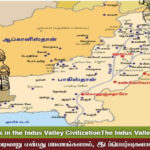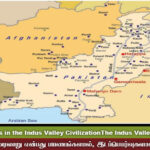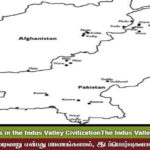

Tamil Names in the Indus Valley Civilization The Indus Valley Civilization
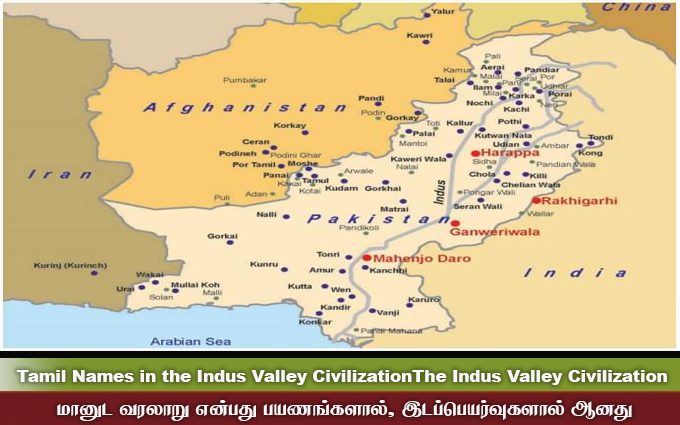
Tamil Names in the Indus Valley Civilization The Indus Valley Civilization (often abbreviated as IVC), which spanned across regions in present-day Afghanistan, Pakistan, and northwestern India, exhibits intriguing links to Tamil culture and Sangam literature. The discovery of place names in these regions that bear striking resemblance to names from ancient Tamil literature, particularly Sangam texts, provides compelling evidence of potential cultural and migratory connections between the Indus Valley and ancient Tamil societies.KVT Complex: Korkai, Vanji, ThondiThe “KVT Complex,” named after the ancient Tamil cities of Korkai, Vanji, and Thondi, stretches across parts of modern Afghanistan and Pakistan. These cities were vital centers of commerce and culture during the Sangam period (circa 300 BCE to 300 CE). Remarkably, the names of these cities, along with other places such as Matrai, Urai, and Kudalgarh, are still found in regions of Pakistan today. Similarly, cities like Gurkay (Gorkhai) and Pumpuhar in Afghanistan correspond to Korkai and Puhar (Poompuhar) from ancient Tamil texts.Rivers:
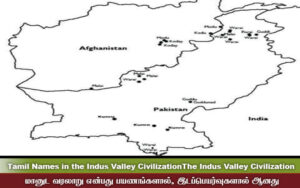 Kawri and PorunsEven the names of rivers in Afghanistan and Pakistan mirror those found in Sangam literature. The rivers Kawri and Poruns in Afghanistan, as well as the Kaweri Wala and Phornai in Pakistan, closely resemble the ancient Tamil rivers Kaveri and Porunai, showing a continuity in place names that transcends geographical and temporal boundaries.The Power of Place NamesAs the Indian linguist L.V. Ramaswami aptly stated: “Where history begins to be silent, place names open their mouths to speak.” This sentiment captures the idea that while historical records may fade or disappear, place names remain as lasting evidence of past migrations and cultural exchanges.Humans, as they migrate, carry with them memories of their homeland, and they often transfer the names of their original settlements to new locations. This phenomenon creates a psychological link to their past and provides a sense of continuity and security.
Kawri and PorunsEven the names of rivers in Afghanistan and Pakistan mirror those found in Sangam literature. The rivers Kawri and Poruns in Afghanistan, as well as the Kaweri Wala and Phornai in Pakistan, closely resemble the ancient Tamil rivers Kaveri and Porunai, showing a continuity in place names that transcends geographical and temporal boundaries.The Power of Place NamesAs the Indian linguist L.V. Ramaswami aptly stated: “Where history begins to be silent, place names open their mouths to speak.” This sentiment captures the idea that while historical records may fade or disappear, place names remain as lasting evidence of past migrations and cultural exchanges.Humans, as they migrate, carry with them memories of their homeland, and they often transfer the names of their original settlements to new locations. This phenomenon creates a psychological link to their past and provides a sense of continuity and security.
Such place names act as silent witnesses to ancient civilizations, preserving their legacy through time.Indus Valley Civilization and Tamil ConnectionsThe settlements found along the banks of the Ravi River in Punjab, Pakistan, particularly at Harappa, and further downstream at Mohenjodaro on the Indus River, have been linked to a civilization that flourished around 3000 BCE. These cities, which housed as many as 30,000 people, exhibited advanced infrastructure, further reinforcing the possibility of connections between the Dravidian-speaking populations of the Tamil region and the Indus Valley people.Retired IAS officer R. Balakrishnan has expanded on this connection by identifying striking similarities between place names in the Indus Valley and those mentioned in Sangam literature. His research into the “Korkai-Vanji-Thondi” complex offers fresh insight into the long-standing hypothesis that the ancient Tamil people had interactions with or perhaps even originated from regions associated with the Indus Valley Civilization.Place Names and MigrationsMany place names existed long before the rise of major civilizations, and they often survived the decline of those civilizations. Even as languages evolved and new populations settled in these areas, ancient place names remained resilient, preserving the memory of ancient peoples.
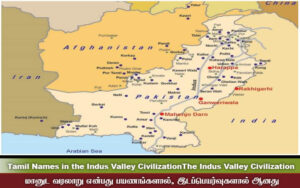 Researchers such as Allchin, Sangalia, Asko Parpola, Iravatham Mahadevan, and F.C. Southworth have all examined these connections. Asko Parpola, a professor at the University of Helsinki, has posited that understanding the names of places in Harappa could be key to deciphering the Harappan language. Similarly, Mahadevan believes that the earliest inscriptions of the Indus people may include place names, further linking them to the Tamils .Examples of Tamil Place Names in the Indus RegionMany current place names in Pakistan and Afghanistan bear a striking resemblance to the names of cities, ports, and rivers mentioned in Sangam literature. For instance:Gorkai (Pakistan) resembles Korkai, the ancient port city of Tamilakam.Vanji (Pakistan) recalls Vanji, the capital of the Chera dynasty.Tondi (Pakistan) corresponds to Thondi, another ancient Tamil port.Kaweri Wala (Pakistan) and Poruns (Afghanistan) remind us of Kaveri and Porunai, two major rivers in Tamil history.
Researchers such as Allchin, Sangalia, Asko Parpola, Iravatham Mahadevan, and F.C. Southworth have all examined these connections. Asko Parpola, a professor at the University of Helsinki, has posited that understanding the names of places in Harappa could be key to deciphering the Harappan language. Similarly, Mahadevan believes that the earliest inscriptions of the Indus people may include place names, further linking them to the Tamils .Examples of Tamil Place Names in the Indus RegionMany current place names in Pakistan and Afghanistan bear a striking resemblance to the names of cities, ports, and rivers mentioned in Sangam literature. For instance:Gorkai (Pakistan) resembles Korkai, the ancient port city of Tamilakam.Vanji (Pakistan) recalls Vanji, the capital of the Chera dynasty.Tondi (Pakistan) corresponds to Thondi, another ancient Tamil port.Kaweri Wala (Pakistan) and Poruns (Afghanistan) remind us of Kaveri and Porunai, two major rivers in Tamil history.
Additionally, place names such as Amber, Toti, Illam, Kachi, Kong, Ner, and Nalai found in Pakistan echo similar names from ancient Tamil texts, underscoring the shared cultural heritage between the Indus region and Tamilakam.Mountains and Rivers in Tamil LiteratureIt is not just cities and ports, but also the names of mountains and rivers that reveal a deep connection. The Sangam texts mention mountains like Podhigai and rivers like Kaveri and Porunai. Correspondingly, in Afghanistan and Pakistan, we find rivers named Kawri, Poruns, and Puronai, as well as mountains called Podineh and Palani, which evoke the Tamil names of these natural features.Conclusion: A Shared LegacyThe persistence of Tamil place names in the Indus Valley and surrounding regions is not accidental. These names, found both in ancient Tamil literature and in modern geography, offer a tantalizing glimpse into the shared cultural and migratory history of the Tamil people and the Indus Valley Civilization. These place names may well hold the key to unlocking further understanding of the ancient Tamil people and their ties to one of the earliest known urban civilizations. <Denne besked er blevet redigeret>
சிந்துவெளியில் தமிழ் பெயர்கள்! (Tamil names in Indus Valley!)
KVT Complex (Korkai-Vanji-Thondi) spread over Afghanistan and Pakistan has many Places, Names of those were mentioned in Sangam Literature. Korkai, Vanji, Tondi, Matrai, Urai and Kudalgarh are the names of places in Pakistan.
Gurkay and Pumpuhar in Afghanistan are related to the cities and ports mentioned in the Sangam Age
The names of the rivers Kawri and Poruns in Afganistan and the rivers Kaweri Wala and Phornai in Pakistan also occur in the Sangam Literature.
Quotes
